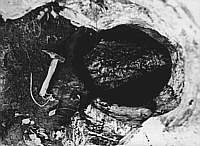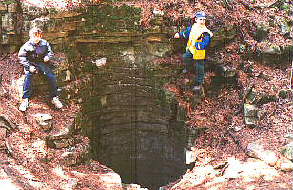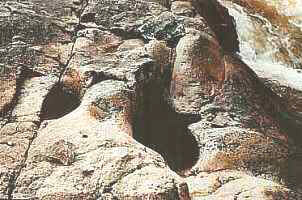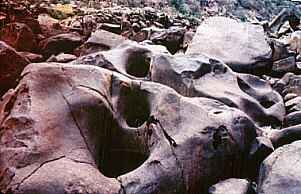Eagle's Nest Potholes
Along the top of the spectacular cliffs of the Niagara Escarpment in
Ontario
there are several locations where potholes occur. On the Bruce
Peninsula,
a large pothole is exposed in the face of the cliff near Lion's Head.
It
is locally known as the "Eagles' Nest" because of several rounded
boulders
that remain in it, that are visible from boats on the lake. Its
location
is in the center of the cliff in the photo at right. |
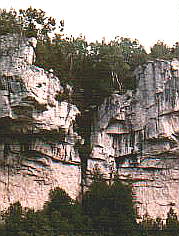 |
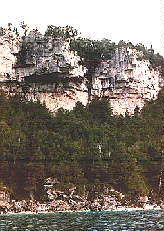 |
These two photos show the location of the potholes depicted
on this
page in a high cliff overlooking the lake. The 'Eagle's Nest' is a
pothole
in the cliff face behind the trees, overlooking Isthmus Bay near Lion's
Head. It is associated with several smaller potholes. |
| The map at right shows the location of the village of Lion's
Head,
at latitude 45o North on the eastern
shore
of the Bruce Peninsula. Potholes are found on the cliffs of the Niagara
Escarpment nearby. |
 |
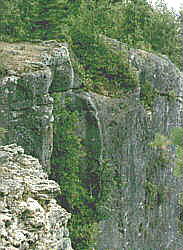 |
According to the conventional uniformitarian explanation of
potholes
found in many geology text books, potholes like these were caused by
vortices
in former streams that rotated and vibrated "grinding stones" over long
ages of time, the process gradually wearing down a deep, cylindical
hole
into the rock. In this case, however, the circumstances seem to
discredit
this explanation. Of course it is unlikely vortices could have existed
high on the face of a steep cliff, and rotation could not be maintained
in a hole if one side of it was missing. |
 |
The picture at left shows portions of two potholes that
intersect,
at the top of the cliff near the site of the previous pothole.
It is common to find partial potholes, where only a portion of
a vertical
cylindical hole remains in the side of a gorge or cliff. The theory of
vortices whirling those grinding stones appears absurd when one tries
to
imagine how the stones could be down in the holes whirling around and
around
where one wall of the pothole was missing. And with part of the wall of
a pothole missing, how could the currents have continued to circulate?
What would keep the "grinding stones" from falling out, and tumbling
down
the cliff?
|
 |
The image at left is a view looking down into one of the
potholes from
above. Some large rounded boulders are present in the pothole. |
 |
The boulders of the "Eagle's Nest" can be seen in the
potholes in this
photo. If there were a waterfall tumbling down the cliff here, no doubt
many would assume the water had eroded the potholes. But in this
location,
no waterfalls are likely to have existed long enough to erode
them.
Rivers may have removed partially unconsolidated material, and
sand,
gravel, or drift, from potholes, and are often still doing so today. My
research indicates the rivers had nothing to do with forming the
potholes,
but merely exposed them. The conditions in which the potholes formed
were
unlike those of the present. Potholes in some rocks probably formed
during
compaction, as joints formed in the rock. Many of the intersecting
potholes
are aligned along joints.
|
 |
Another pothole near the top of the escarpment which opens
into the
larger Eagle's Nest pothole. A small tree is growing inside the
pothole. |
 |
View from the top of the cliff at the Eagle's Nest, looking
down. Note
the boulders and gravel in the pothole. |
| The dolomite rock of the Niagara Escarpment where these
potholes occur
is part of the Amabel formation.
The rock is deeply fissured, and because of this, there are no
surface
streams in the area that could have eroded potholes. The distribution
of
the potholes does not suggest the action of streams, as they are
scattered
over a wide area above the escarpment. Many potholes are situated in
locations
that seem unlikely to have ever been the sites of former streams.
|
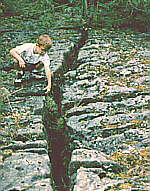 |
 |
The view along the rugged and scenic cliffs of the Niagara
Escarpment,
looking west towards Lion's Head harbor in the distance. |
